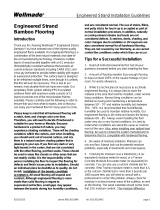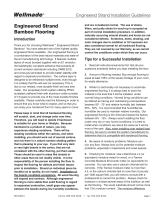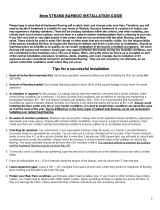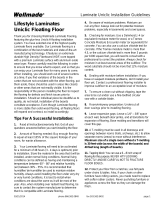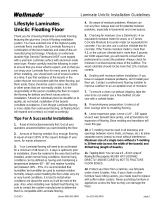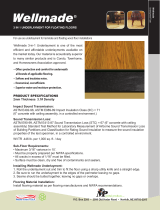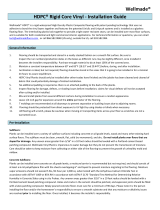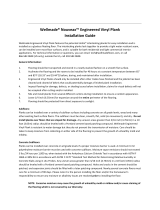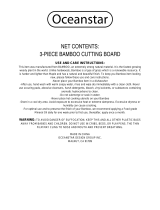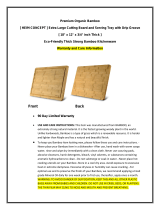Page is loading ...

Tongue-and-Groove Installation Guidelines
phone 866.582.0848
fax 503.582.8402 page 108/19/2009
Solid Bamboo Flooring
Introduction
Thank you for choosing Wellmade Performance
Bamboo Flooring! You have selected one of the highest
quality bamboo floors available. As you might expect,
Wellmade is always looking for ways to improve the
quality of our products and related services. Please
carefully read the following in order to ensure that you
know what to expect, and so that you can enjoy your
new bamboo floor for many years to come.
Please keep in mind that bamboo flooring will
scratch and dent like any other hardwood flooring.
Because bamboo is a natural product, you may
experience shading variations. Although we sort
into shading categories, there will still be shading
variations within the cartons. When installing, you
should work out of at least several cartons, and mix
them in a natural random shading pattern that is
pleasing to your eye. If you find very dark or very
light planks in the carton, DO NOT INSTALL. It is
the responsibility of the person installing the floor to
inspect the flooring for defects and shading issues
prior to installation. All wood flooring will expand
and contract. This means that gaps may appear
between the planks during low humidity conditions,
and are considered normal. Scratches, dents, and
shading are not covered by our Warranty, as we
cannot control the conditions under which they
can occur.
Tips for a Successful Installation
1. Read all instructions/warranty first: Get all your
questions answered before you start installing the floor.
2. Amount of flooring needed: Buy enough flooring to
equal at least 105% of the square footage of your room,
for waste allowance.
3. Before installing, open all boxes and let flooring sit
in room for 3 to 4 days to acclimate to temperature and
moisture. Run air conditioning or heat, as it will be in
normal living conditions. Normal living conditions can
be defined as having and maintaining a temperature
between 50° - 70° and relative humidity (air) between
35% - 55%. It is recommended that humidifier/de-
humidifier be used to maintain relative humidity. The
bamboo flooring is kiln dried and leaves the factory
between 8% - 10%. Always avoid installing the floor
under very dry or very humid conditions, it is best to
install when conditions are about the same as it will
be most of the year.
4. Be aware of moisture problems: Moisture can
ruin any floor. Always look out for potential moisture
problems, especially in basements and crawl spaces.
5. Checking for moisture: Use a Delmhorst J-4 (or
equivalent) moisture meter for wood, or a Tramex
Concrete Moisture Encounter meter (or equivalent) for
concrete. You can also use a calcium chloride test for
concrete. If the Tramex moisture meter is more than
4.5%, or the calcium chloride test is more than 3 pounds
per 1000 square feet, you will need to consult with a
professional to correct the problem. Always check for
moisture in at least several areas of the sub-floor, as
well as the flooring. The moisture difference between
the sub-floor and the bamboo flooring must be no more
than 4%.
6. Dealing with moisture before installation: If you have
or suspect moisture problems, don’t install your floor
yet. Contact a professional flooring installer to improve
sub-floor to an acceptable level of moisture.
7. To ensure a clean cut without any splintering, tape
the area to be cut and/or use a fine-toothed circular saw
with a carbide blade. Generally this is not necessary as
it will be covered.
8. Place all nails/staples at 6 – 8 inch intervals along
the tongue of the boards, and not closer than 3” from
the end.
9. Room/entryway preparation: Undercut door casings
are much better than trying to scribe the flooring to
fit there.
10. Leave expansion gaps: Leave a 3/8" – 5/8” space
at each wall, beneath door jambs, and at transitions for
expansion of flooring. Base molding and transitions will
cover this gap.
11. Tapping block: You can use a 6 – 8 inch scrap
of flooring for this purpose. NEVER HIT FLOORING
DIRECTLY AND BE CAREFUL NOT TO FRACTURE
FLOOR EDGES.

Tongue-and-Groove Installation Guidelines
phone 866.582.0848
fax 503.582.8402 page 208/19/2009
12. Protect your bamboo floor from scratches. Use felt
pads under chairs & tables. Also, if your chairs or other
furniture have rolling castors, you made need to replace
with softer rubber castors. Never push/drag furniture
or appliances across the floor as they can damage
the finish. Please remember that scratches and dents
are not covered by warranty.
NOT A PROBLEM:
1. Bending or bowing of the boards in length direction.
These boards might be a little harder to install, but will
NOT be a problem after they are installed, or in the
future. They will lay flat like the others.
2. Color Variations will occur as bamboo is a natural
product like oak and other hardwoods.
PLEASE READ BEFORE INSTALLING
Responsibilities of the Owner/Installer:
Bamboo flooring is a natural and environmentally
friendly product. If you take care to install this flooring
correctly, taking all precautions suggested in this
guideline, the flooring will give you many years of
satisfaction. Please note that it is always best to have
your floor installed by a professional, even though
it is possible to install yourself. This is only guideline
and cannot supply all the details you may encounter
regarding the installation of this flooring. Detailed
preparation and installation procedures are outlined by
the National Wood Flooring Association’s Hardwood
Flooring Manual (NWFA) 1-800-422-4556 or www.nwfa.
org. Wellmade cannot be responsible for the installation
under any circumstances.
Pre-Installation Procedures/Acclimation:
Please handle, transport, and unload the flooring with
care. Flooring should be stored in a dry place, with
at least a four-inch air space under cartons. Flooring
should not be delivered until the building has been
closed in with windows and doors in place, and
until cement work, plastering, painting, and all other
materials are thoroughly dry. Acclimate the flooring
for at least 72 hours (preferably 3-4 days) prior to
installation In addition, the heating or cooling system
should be operating and controlled at 50° – 70° for
at least 72 hours before, during and maintained after
installing. Do not install in areas that are subject to
extreme seasonal temperature/humidity changes
where you cannot control the temperature/
humidity. As with all hardwood flooring, it is best if
the humidity is maintained year-round to help prevent
small gaps from appearing when humidity levels are
very low. Precautions should be taken if you are
installing in very dry or very humid conditions. The
flooring is shipped from the factory between 8 – 10%
moisture content. In some cases it will be necessary
to use humidifiers or dehumidifiers to maintain the
best environment for wood flooring. Please consult a
professional for guidance in your area.
Moisture Test: Before installing over concrete or a
wooden sub-floor, check it for moisture in several areas
using wood or concrete moisture meter. You may also
test concrete floors using the calcium chloride test.
Also test the flooring materials. The moisture difference
between the sub-floor and the bamboo flooring must be
no more than 4%.
Before installation, lay out the flooring where it is to be
installed (that is, lay the boards down roughly as they
will appear after installation), taking care to mix it in a
shading pattern pleasing to your eye. Installer should
inspect each plank at this time for finish and quality.
Once installed, it becomes the responsibility of the
installer/homeowner. Normally you will want to start
your installation along the longest outside wall, and it is
best if your flooring is installed perpendicular (across)
to the floor joists. If possible, you will want to orientate
the boards with the major source of light (windows) so
that light is shining down the length of the boards, rather
than across the boards. Remember that all natural
flooring comes in a range of colors and shades. Our
quality control procedures at the factory ensure that
very few, if any defective boards are delivered to the
consumer. Remove baseboards and undercut door
jambs to insure a quality installation.
Recommended Areas:
Bamboo flooring is recommended for on or above
grade installation only. On grade is defined as being at
the soil level, and above grade is above the soil level.
Bamboo flooring should not be installed in wet areas
such as bathrooms (with tub/shower) or mud rooms.

Tongue-and-Groove Installation Guidelines
phone 866.582.0848
fax 503.582.8402 page 308/19/2009
Crawl Space Ventilation:
Proper air circulation is important to prevent moisture
build up, especially in homes with a crawl space. Vents
should be open year round. Check to make sure that
there is no standing water or moisture at the soil level.
If moisture is present, soil should be covered with 6 mil
polyethylene to prevent moisture from migrating into the
wood flooring.
Acceptable Sub-Floors:
The sub-floors must be on or above grade & structurally
sound. Bamboo flooring can be installed over the
following sub-floors:
- Existing wood floors
- Plywood (¾" thick)
- Sheathing grade
- Oriented Strand Board (OSB - at least ¾" thick
underlayment grade)
- Vinyl tile
- Concrete floors (2 in 1 adhesive and moisture
barrier recommended)
DO NOT INSTALL DIRECTLY OVER PARTICLE BOARD,
WAFERBOARD, PRESSED WOOD, OR FIBER BOARD,
except when installing with an adhesive system. Due
to differences in the many types of radiant heat
flooring, we do not recommend installing over
radiant heat floors.
Sub-Floor Preparation:
The sub-floor must be structurally sound and checked
for moisture content. Movement and squeaks should be
well fastened with ring nails or screws to the floor joists.
The sub-floor must be clean and free of paint, wax, oil,
and other debris. In addition it must be flat and level
within 3/16" inside a 10' radius. High spots must be
sanded flat and low spots must be filled with a leveling
compound recommended by your dealer. On old or
uneven wood floors, apply 1/4"- 5/8" plywood and ring
nail or screw every 6” to avoid squeaking (it is also a
good idea to glue the panels with a
construction adhesive).
For Creating A Random Effect:
To avoid creating a joint pattern in the floor, it is
necessary to begin installation using starter boards. To
create a starter board, cut the board at 2/3 the length.
Start with the 2/3 length, and then install the full lengths
and continue across the room. Use the 1/3 length to
start the next row and continue as above keeping at
least a 8” distance between the end joints. Cuts made at
the opposite wall should be used for starter boards, so
as to avoid a pattern. If necessary, use pull straps at 3
ft. intervals to hold the planks firmly together, or use blue
painters tape. Be sure to allow at least a 3/8” – 5/8”
expansion gap around perimeter.
Please keep in mind that tools left on the finished
floor during installation will more than likely scratch
the floor. It is also important that debris be removed
from the finished areas immediately, and that all
persons who might walk on the floor before it is
finished should clean the bottom of their shoes.
The more traffic you have on the floor before the
installation is completed, the more likely it can
be damaged.
For Adhesive Installation:
There are many suitable adhesives that may be used,
if you are not a professional installer, consult with
your local flooring dealer for recommendations for the
proper adhesive for hardwood installation. You will
need to use a urethane adhesive. Do not use water-
based adhesives. In addition to the adhesive, some
manufacturers offer moisture barriers that may be
used with their adhesive system, be sure to contact
manufacturer of the adhesive for proper use. Use a
chalk line and leave at least a 3/8” space (smaller
rooms) along the wall for expansion. Start with only
a few rows, be sure to align perfectly, and then allow
it to set until the planks will not move when adding
additional rows. Every now and then, check to see
if you are getting a good transfer of the adhesive to
the back of the planks. Roll the flooring with a 150 lb.
roller to ensure adhesive transfer to back of bamboo
planks, be sure there is not any debris on the roller
which may scratch your floor. You can also “walk” the
planks as you are installing. This will help insure that
the planks are not “bridging” across low spots in the
sub-floor. It is very important that the planks be firmly
attached to the sub-floor. Be sure to clean up any
adhesive on the surface immediately, as once it dries, it
may be very difficult to remove and damage the finish.
Always follow adhesive manufacturers’ instructions
using their suggested adhesive and installation
instructions for their adhesive warranty to be
in effect.

Tongue-and-Groove Installation Guidelines
phone 866.582.0848
fax 503.582.8402 page 408/19/2009
For Nail/Staple Installation:
If you are not a professional flooring installer, you will
need to rent a special nailer for hardwood flooring.
This tool will allow you to nail/staple the floor so that
they will not show on the finished floor. Be sure to
learn how to adjust the nailer so as not to damage
the tongue. Also, be sure that the nailer is designed
for or can be adjusted or shimmed for the appropriate
flooring thickness. You will need to use 1 1/2" nails/
staples for this application. Nails/staples should be
placed about 6 – 8 inches apart, and not closer than 3
inches from the end of the plank. The first and last rows
will generally need to be nailed by hand next to the wall,
as the nailer will not work in these areas. Pre-drill for
6d finish nails, counter sink, and fill the nail holes with
matching putty. Be sure not to place nails too close to
the edge of planks so as to prevent splitting. Generally
it is not necessary to use a moisture barrier over wood
sub-floors. If you prefer, you can use roofing felt as with
any hardwood flooring. Remember to leave at least 3/8”
– 5/8" expansion gap around
the perimeter.
Splitting of the tongues is a problem normally related to
the nailer, not the flooring. If the pressure is adjusted
properly; and the nailer is designed or can be adjusted
(shimmed) for the right flooring thickness so that the
nail/staple is entering in the proper place, at the proper
angle; and you are still splitting the tongue, you may
need to go to a smaller gauge nail/staple.
Completing the Job:
Inspect your work, as it will cost you more if you have
to come back to do a repair later. Replace original
baseboards, or install matching bamboo baseboard.
Install matching transitions as needed or recommended
by your dealer or installer. It is not recommended or
necessary to seal this floor after installation. Protect
your floor from scratches by using felt pads on chair
legs or furniture feet. Plastic rollers/castors can
damage your flooring; if necessary, try to replace
with softer rubber wheels/castors. When moving
heavy items like refrigerators, use at least two sheets
of 1/4" masonite or plywood while moving (sliding
the appliance from one sheet to the next) to protect
the flooring against scratching and denting.
Congratulations! You have just installed an
environmentally friendly, beautiful, and elegant
Wellmade Performance Bamboo Floor!
/
